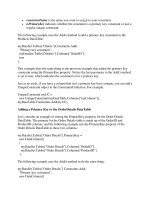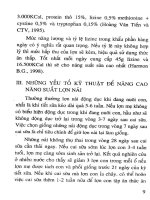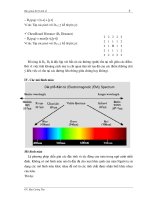Zoos and Animal Welfare Phần 2 ppsx
Bạn đang xem bản rút gọn của tài liệu. Xem và tải ngay bản đầy đủ của tài liệu tại đây (531.13 KB, 12 trang )
Animals in zoos are forced to live in artificial, stressful, and
boring conditions, according to the Captive Animals’
Protection Society (CAPS), an organization that campaigns
against keeping wild animals in captivity. Zoo enclosures
rarely match each animal’s natural environment, forcing
species that would travel hundreds of miles a day in the wild
into small enclosures. Many zoo animals are so bored and
unhappy that they exhibit stereotypical behaviors includ-
ing needless pacing, swaying, rocking, and self-mutilation.
In addition, important social relationships between animals
are destroyed as zoos trade or sell animals. According to the
CAPS, wild animals need to live where they can exhibit
natural behaviors—in the wild.
W
orldwide there are probably more than 10,000 zoos, with
hundreds of thousands of animals held captive.
Zoos are a relic of a bygone age—a Victorian concept which,
as our knowledge of the animal kingdom grows, becomes even less
palatable.
An increasing number of people are concerned about keeping
wild animals captive. So zoos claim they are on a greater mission
12
The Captive Animals’ Protection Society
ONE
Animals Suffer in
Captivity
The Captive Animals’ Protection Society, “Sad Eyes and Empty Lives: The Reality of Zoos,”
www.captiveanimals.org, 2006. Reproduced by permission.
Zoos_ITCY_v5.qxd 11/5/07 5:31 PM Page 12
than simple entertainment: for conservation, education and
research. Zoos now favour terms like ‘wildlife park’ or even ‘sanc-
tuary’.
The Captive Animals’ Protection Society [CAPS] is totally
opposed to the incarceration of animals and believes that zoos
misinform rather than educate, and further, divert funds from pos-
itive conservation. Animals remain threatened or are even driv-
en to extinction, whilst precious resources are drained away on
expensive, high-profile breeding projects with no serious hope of
success.
Sad Eyes and Empty Lives
In the wild, animals react to their surroundings, avoiding preda-
tors, seeking food and interacting with others of their species—
doing what they have evolved for. Consequently, even what might
seem ‘larger’ or ‘better’ enclosures may be completely impover-
ished in terms of the animals’ real needs.
Frustration and boredom are commonplace amongst animals
in zoos and can lead to obsessive and repetitive behaviours in the
form of pacing, swaying, and even self-mutilation. This is known
as stereotypic behaviour and such pointless, repetitive movements
have also been noted in people with mental illnesses. With noth-
ing to do, animals in zoos go out of their minds. Disturbed mater-
nal behaviour may involve over-grooming and the rejection or
killing of young.
Studies by Oxford University scientists found that lions in zoos
spend 48% of their time pacing and 40% of elephants performed
stereotypic behaviours.
Even diets are unnatural, with zebras in zoos becoming over-
weight as the grass they are given is higher in calories than the
grasses of the African savannah. The resulting obesity can affect
fertility.
CAPS have filmed adult gorillas in zoos repeatedly eating their
own vomit. A gorilla biologist, who studied wild gorillas in Rwanda
with the late Dian Fossey, told CAPS: “I have never seen wild
gorillas perform R&R (regurgitate and re-ingest, as it’s known in
Animals Suffer in Captivity 13
Zoos_ITCY_v5.qxd 11/5/07 5:31 PM Page 13
the zoo world, being such a well known by-product of captivity)
and I have never spoken to anyone who has. In fact, I have never
seen a wild gorilla vomit.”
Some animals suffer such serious behavioural problems in
zoos that they are given anti-depressants, tranquillisers and anti-
psychotic drugs to control their behaviours.
Zoos often refer to the animals they confine as being ‘ambas-
sadors’ of their species, but just what message does it give when
we see animals in such unnatural conditions, displaying disturbed
behaviours?
The Longest Life Sentence
Space in zoos rarely, if ever, matches the animals’ natural range.
Animals who would naturally roam for tens of miles a day tread
the same few paces daily. Some of the fastest animals on earth live
in pens so small that they could not gather pace to a trot, let alone
full speed.
A study published by CAPS revealed that enclosures in UK
[United Kingdom] zoos and safari parks are on average 100 times
smaller than the minimum home range in the wild for the ani-
mals they contain.
Another study of zoos worldwide found that lions and other big
cats have 18,000 times less space in zoos than in the wild, and that
figure rises to one million times less space for captive polar bears.
For fifteen hours a day, many animals may be shut away in their
night quarters with even less room to move.
Some zoo enclosures prevent the inmates from enjoying even
their most basic behavioural repertoire including exercise and
social interaction. Birds are virtually stripped of their most pre-
cious gift, flight, often able to do little more than flutter their
wings. Consequently, birds in zoos are prone to arthritis and osteo-
porosis.
However, it is not just a matter of space, but also the quality of
the environment.
Chimpanzees are our closest relatives in the animal kingdom,
their intelligence is universally accepted, but they exchange the
14 Zoos and Animal Welfare
Zoos_ITCY_v5.qxd 11/5/07 5:31 PM Page 14
infinite possibilities of the forest for little more than playground
climbing frames which would not keep a human child occupied
for hours, let alone years.
Reptiles need complex thermal ranges, variation in humidity,
special phases of light and other factors that may seem difficult
for us to appreciate as humans.
Zoos rarely have the numbers to match the natural social inter-
action of herd animals. And when animals do find company, their
world may be torn apart when cage mates are sold or become excess
to requirements.
Animals Suffer in Captivity 15
Percentage of Zoo Animals That
Exhibit Stereotypical Behaviors
Zoos_ITCY_v5.qxd 11/5/07 5:31 PM Page 15
Solitary and shy animals are often in enclosures with viewing
from all sides, and even a window in the night quarters as well. A
study of gorillas in Belfast Zoo found that when there were more
visitors the gorillas displayed “more behaviours suggestive of agi-
tation, such as repetitive rocking, group-directed aggression and
self-grooming.”. . .
16 Zoos and Animal Welfare
Animals bonding with their handlers in zoos is seen by some
as a sign of the lack of activity animals experience in zoos.
Zoos_ITCY_v5.qxd 11/5/07 5:31 PM Page 16
Zoos Today
Zoos claim that seeing a live wild animal gives an unparalleled
appreciation of the power and wonder of nature, but what are they
really showing us?
TV wildlife programmes have ensured that our understanding
of these animals extends beyond these pathetic exhibits. Indeed,
CAPS believes school trips to zoos leave children with a distort-
ed view of wildlife. A study of zoo visitor attitudes found that after
people saw animals in zoo enclosures that were highly artificial
they had “a significantly greater negativistic and dominionistic
attitude to animals.”
Signs on zoo enclosures can often give little information, or
even incorrect details. A CAPS study of public aquaria in the UK
found that 41% of the individual animals on display had no signs
identifying their species—the most basic of information.
Studies have shown that most visitors spend less than three
minutes looking at each exhibit, and sometimes as little as eight
seconds.
We don’t need to be wealthy to see animals in the wild. Wildlife
is all around us, whether we live in a city or the countryside. From
birds in the garden to badgers and deer in the woodland, we can
all explore wildlife in its natural habitat with as little—or as
much—effort as we want to put in.
Zoos claim that they afford people the opportunity to see some-
thing that many will never see in the wild. This is true; we will
have to make do with books, magazines and television. However,
can a few minutes of entertainment ever justify the tragedy of the
disturbed behaviours and suffering we have outlined?
Animals Suffer in Captivity 17
Zoos_ITCY_v5.qxd 11/5/07 5:31 PM Page 17
Like most top zoos in the United States, the Philadelphia
Zoo features state-of-the-art animal exhibits and cutting-
edge health care. In addition to caring for the safety and
physical well-being of its animals, the zoo also facilitates
programs that nurture psychological health. According to
the zoo’s Web site, animals are placed in social environ-
ments that closely mimic their relationships in the wild,
and they have opportunities to engage in many natural
behaviors. The zoo also provides ample enrichment oppor-
tunities for exploration and novelty. The Philadelphia Zoo
is one of the world’s most renowned zoological societies and
gardens, drawing more than 1.1 million visitors a year.
18
The Philadelphia Zoo
TWO
Animals Do Not
Suffer in Captivity
Zoos_ITCY_v5.qxd 11/5/07 5:31 PM Page 18
Animal siblings playing in a zoo environment can help ensure
their psychological as well as physical health.
20 Zoos and Animal Welfare
Zoos_ITCY_v5.qxd 11/5/07 5:31 PM Page 20
Animals Do Not Suffer in Captivity 21
Speed Bump © 2004 Dave Coverly. Used with the permission of Dave Coverly and The
Cartoonist Group.
Zoos_ITCY_v5.qxd 11/5/07 5:31 PM Page 21
22 Zoos and Animal Welfare
Zoos_ITCY_v5.qxd 11/5/07 5:31 PM Page 22
Animals Do Not Suffer in Captivity 23
Zoos_ITCY_v5.qxd 11/5/07 5:31 PM Page 23






![[Nông Nghiệp] Kỹ Thuật Trồng Đậu Nành - Ks.Nguyễn Việt Thái phần 2 ppsx](https://media.store123doc.com/images/document/2014_07/13/medium_dlf1405268425.jpg)


